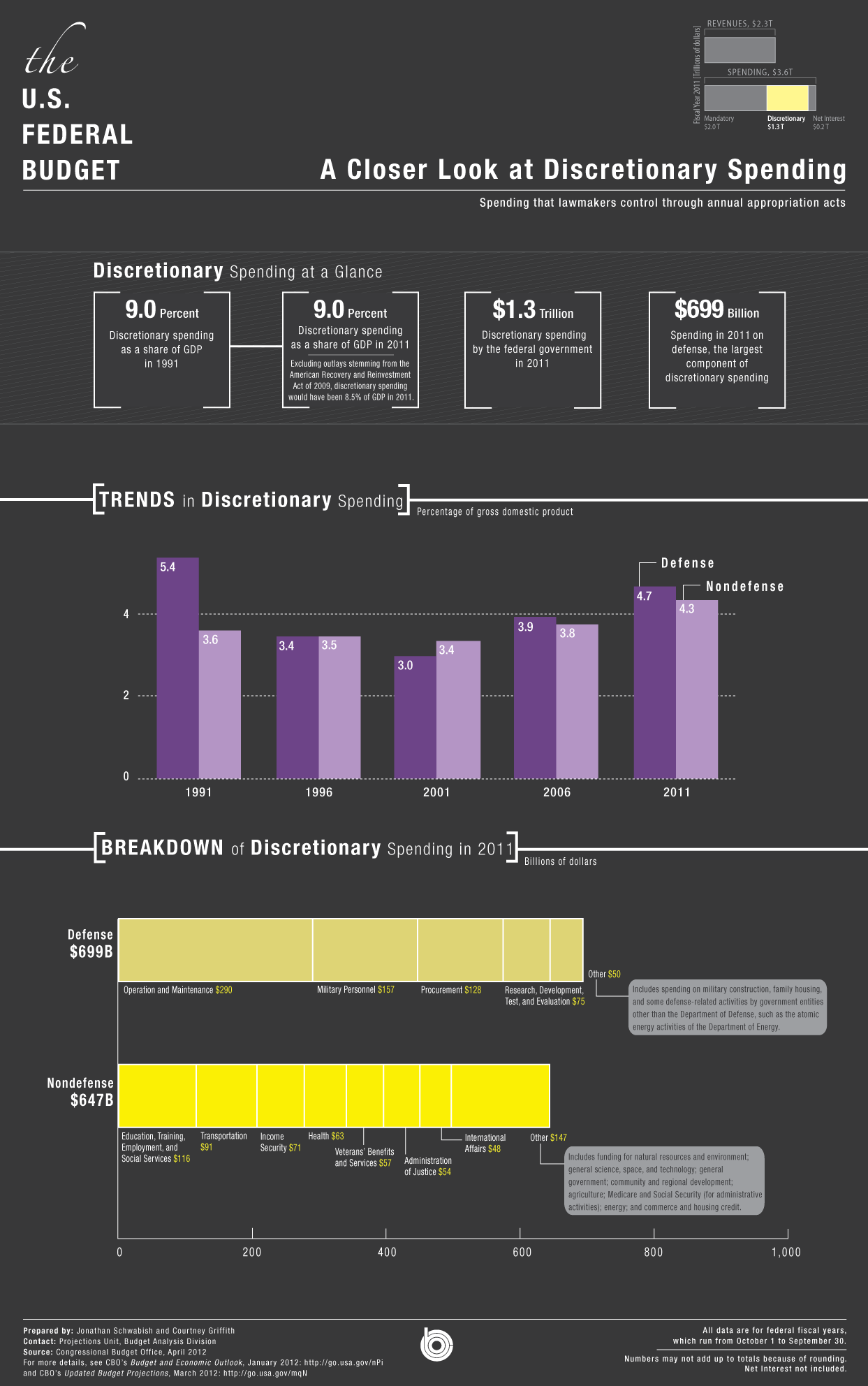Fresh from the Congressional Budget Office, three new handy infographics illustrating federal money coming in, and going out.
- Federal revenues
- Mandatory spending
- Discretionary spending
- Earlier grafic on the budget.

Fresh from the Congressional Budget Office, three new handy infographics illustrating federal money coming in, and going out.

A calculator from the White House lets you figure where your tax dollars went in 2011, including toward national security related efforts. Below is for a married couple with two kids, making $80,000 a year. Calculate your own.

State-by-state and base-by-base listing of the 3,900 active duty, 5,100 Air National Guard and 900 Air Force Reserve positions the Air Force this week said it would cut, along with details on aircraft cuts.

Can Stars & Stripes retain independence?
The Stars & Stripes military newspaper finds itself battered by two fronts of disruption: First, the same brutal audience and business changes facing all American newspapers, and now, an order from the Pentagon to move its operation to a military base alongside Pentagon military media operations.
Thom Shanker of the New York Times put together a through take on both developments, particularly the latter, which is seen as potentially undermining the credibility and influence of the paper for the sake of saving $1 million a year in rent (from a ~ $700 BILLION budget. That’s .0000014 of 1 percent).
A number of members of Congress have started raising eyebrows and are investigating the implications of the move from the National Press Building to Fort Meade.
And the staff, not surprisingly, is clearly agitated. From Shanker’s story:
“Terry Leonard, editorial director at Stars and Stripes, said he and the staff do not object to moving — only to a move that locates them at the headquarters for official Pentagon media operations.
” “It’s very hard for people to believe that we can be a news organization subsidized by the Defense Department and still be editorially independent,” Mr. Leonard said. “There is a history of improper interference and even censorship by the military and by civilians within the Defense Department.” “

The integrity of Stars & Stripes was a major theme in the sharp and foreboding good-bye column from former S&S ombudsman Mark J. Prendergast (a colleague from way back at the Sun-Sentinel in Florida). From his Jan. 24 column:
Economically, the paper’s survival is imperiled by federal budget cuts and the same challenges other media face — declining audiences and shifts in how people get news and information.
Stars and Stripes can slow or even stave off a dire fate if it defends its editorial integrity, hews to its roots, stays relevant to its readers and remembers their interests come first. And that includes their sensibilities.
This military is an all-volunteer force. Stars and Stripes should deliver hard truths, but never in a tone that says “gotcha” or that disrespects its readers’ chosen life. As the late Washington columnist Mary McGrory counseled journalists, “Be nice to people, but not to power.”
Numbers of the day: Cost per troop in Afghanistan
$850,000 — Department of Defense estimate of what it costs to keep a service member in Afghanistan for a year.
$1.2 million — What the Center for Strategic and Budgetary Assessments says it has cost.
$1.4 million — What the Center esimates it will cost in 2012.
$30,000 — Base pay of an Army sergeant with four years’ experience.
SOURCE: Wired’s Security Clearance.
GAO: Pentagon misreports or ignores long-term weapons costs
“The true costs of some of the biggest pieces of the U.S. arsenal are mostly hidden, the audit concluded, because the Defense Department’s public documents typically list only how much has been spent or will be spent to acquire its fighters, ships, and vehicles.
“The long-term costs of owning such armaments, including all the operations, maintenance, and repair expenses, are often misstated or ignored in the Pentagon’s reports to Congress, or compiled only in an aggregate number that defeats careful analysis of rising costs in individual programs or prudent planning for future military spending, according to the auditors.”
The new White House 2013 budget, to go
 As promised, the Government Printing Office provided a mobile-friendly view of the 2013 White House budget proposal this week. The link to the mobile app is on this page (or scan the QR code to the right, or type m.gpo.gov/budget in your mobile browser). Get the mobile guide to the 112th Congress while you’re on the GPO site.
As promised, the Government Printing Office provided a mobile-friendly view of the 2013 White House budget proposal this week. The link to the mobile app is on this page (or scan the QR code to the right, or type m.gpo.gov/budget in your mobile browser). Get the mobile guide to the 112th Congress while you’re on the GPO site.
A few national security related shortcuts right into the summary available through the mobile version:
Department of Defense highlights
Department of Defense overview table (PDF)
National Intelligence Program (with a nice chunk of black redaction, for good measure!)
Department of Homeland Security overview
Veteran’s Affairs overview
Veteran’s Affairs summary (PDF)
The whole budget document in one 250-page PDF.
Below is what the budget looks like on an iPad
